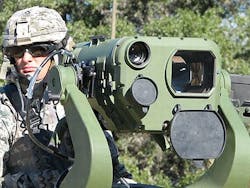Raytheon and DRS help Army upgrade vehicle infrared sensors for targeting and surveillance
Officials of the Army Contracting Command in Alexandria, Va., earlier this month awarded three contracts to Raytheon Co. and to DRS Technologies Inc. for components related to Army third-generation forward looking infrared sensor technology.
Electro optics experts at the Raytheon Co. Missile Systems segment in McKinney, Texas, won a $56.7 million contract on 15 March for engineering, manufacturing and development (EMD) of B-Kits for the third-generation forward looking infrared program.
B-Kits consist of components that will be integrated to sights of ground vehicles, Army officials say. B-Kits for the third-generation forward looking infrared program consist of common components that will be integrated into vehicle sights for reconnaissance, surveillance and target acquisition. These B-Kit upgrades will help Army infrared sensors aboard land vehicles provide a common picture across all host vehicles.
Common components include high-definition mid-wave infrared and long-wave infrared dual-band focal plane array, Dewar Cooler Bench (DCB), optics, and electronics to convert thermal radiation into video images.
Also on 15 March Raytheon Vision Systems in Goleta, Calif., won a $26.8 million contract to design and build a production Dewar cooler bench to improve the Army’s existing third-generation forward looking infrared sensor technology.
Finally, on 15 March the DRS Network & Imaging Systems segment in Dallas won a $26.1 million contract also to design and build a production Dewar cooler bench to improve the Army’s existing third-generation forward looking infrared sensor technology.
Raytheon and DRS are teaming to provide the Army with third-generation forward-looking infrared technology. The two companies also teamed on the Army's second-generation forward-looking infrared program.
Related: The evolution of networked sensors
Third-generation FLIR technology will replace second-generation FLIR sights, starting with those in the Abrams tank and the Bradley fighting vehicle and may expand to include third-generation upgrades to the Long Range Advance Scout Surveillance System (LRAS3) and other current or future ground or aviation sights, Army officials say.
On these contracts Raytheon-McKinney will do the work in McKinney, Texas, and Melbourne, Fla., and should be finished by March 2020. Raytheon-Goleta will do its work in Work will be performed in Goleta, Calif., and should be finished by September 2021. DRS, meanwhile, will do its work in Dallas, and should be finished by September 2021.
For more information contact Raytheon online at www.raytheon.com, or DRS at www.drs.com.
